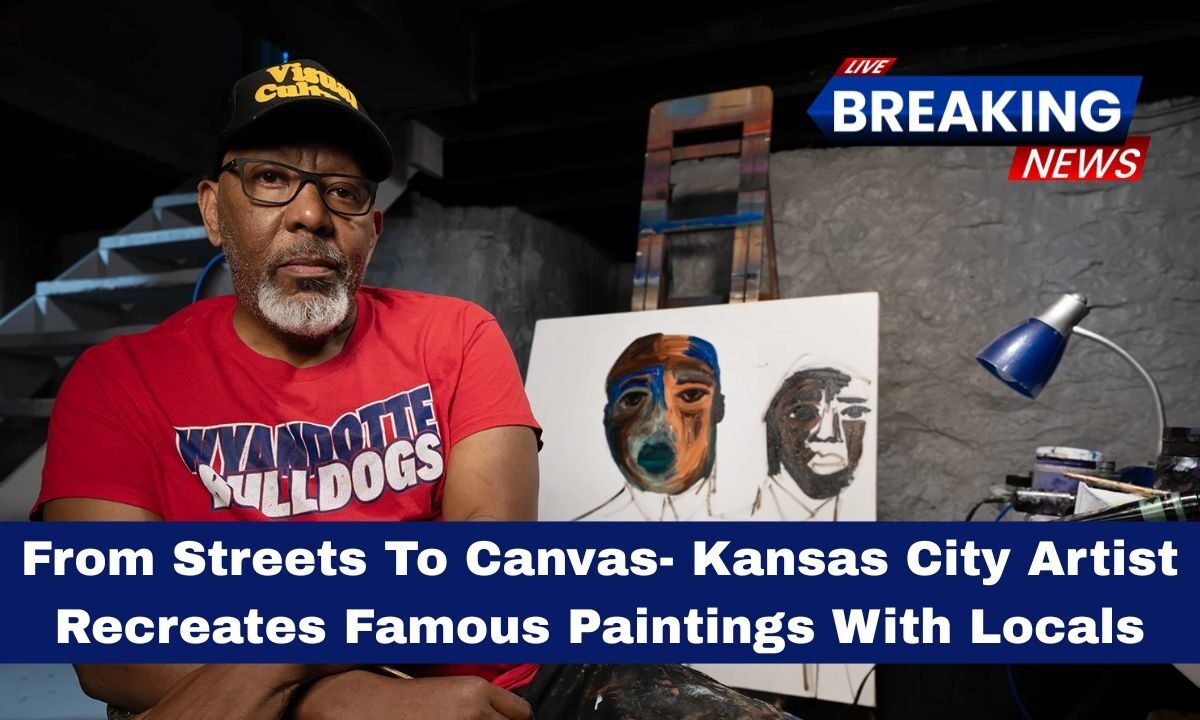Kansas City artist Harold Smith has taken the art world by storm with his bold reimaginings of some of history’s most iconic masterpieces. Instead of European aristocrats or religious figures, his canvases feature neighbors, friends, and everyday people from his Kansas City community.
His series, titled “Around the Way Folk: Saints in Uncommon Places”, transforms classics like Grant Wood’s “American Gothic,” Vermeer’s “Girl with a Pearl Earring,” and Leonardo da Vinci’s “The Last Supper” into powerful reflections of Black identity, culture, and community life.
The exhibit is currently on display at the Mulvane Art Museum at Washburn University in Topeka, Kansas, where it has already drawn local and national acclaim.
The Vision Behind Smith’s Work
Smith describes his style as “Blacktacularization” — a process of inserting Black culture, color, and identity into familiar narratives. His purpose is not just to recreate but to reclaim space in art history, which has often excluded or overlooked Black subjects.
“I still live in the community I grew up in,” Smith says. “My art is an exploration of the people I consider saints and the culture that still exists there.”
Using high-voltage colors, expressive brushstrokes, and palette knife techniques, Smith creates paintings that are vibrant, modern, and deeply rooted in lived experiences.
Exhibit Highlights
| Painting | Original Artist | Smith’s Reimagined Version |
|---|---|---|
| American Gothic | Grant Wood | Features local Black couples from Kansas City neighborhoods. |
| Girl with a Pearl Earring | Johannes Vermeer | Recast with Black women, titled Blacktacularized Girl with a Pearl Earring. |
| The Last Supper | Leonardo da Vinci | A wall-sized triptych filled with faces of friends, neighbors, and community figures. |
| Self-Portrait with the Head of Goliath | Caravaggio | A reimagining titled Blacktacularized Caravaggio, reflecting modern resilience and struggle. |
These works do more than reinterpret art—they bring representation, identity, and dignity to Black communities often excluded from the global art narrative.
Blacktacularization: A Cultural Lens
Smith explains that Blacktacularization is about transforming everyday struggles into triumphs. Inspired by the resilience of Black families, he cites rapper Tupac’s lyrics in “Dear Mama”: “Mama took the little she was given and created miracles every Thanksgiving.”
- Applied to food, it becomes soul food.
- Applied to music, it creates blues and jazz.
- Applied to painting, it becomes Blacktacular art — vibrant, unafraid, and culturally specific.
Through this approach, Smith not only challenges artistic traditions but also celebrates Black resilience, beauty, and creativity.
Recognition and Achievements
Harold Smith is not just a local name. His talent has been recognized nationally and internationally.
- 2022 – Won the Charlotte Street Visual Arts Award.
- 2022 – Received a Pollock-Krasner Foundation Grant.
- 2023 – Selected for the Art Omi International Artists Residency Program.
- Exhibited Locally – The Nelson-Atkins Museum of Art, Nerman Museum of Contemporary Art, and the Lawrence Arts Center.
These milestones solidify his place as a rising force in American contemporary art.
Community and Identity in Art
What makes Smith’s work unique is how he blurs the line between fine art and everyday life. By placing local Black men, women, and children into historically Eurocentric works, he makes a strong statement:
- Representation matters – Black faces deserve to be seen in cultural masterpieces.
- Everyday people are saints – Neighbors and family members hold just as much cultural and emotional value as kings and queens in classical art.
- Art as activism – His canvases highlight inequality while celebrating resilience and identity.
This combination of art and advocacy has struck a chord with viewers who see themselves, their families, and their communities reflected in Smith’s bold paintings.
Museum’s Perspective
The Mulvane Art Museum’s Interim Director, Sara Stepp, has praised Smith’s work as both timely and groundbreaking. She explains that the artist’s reframing of traditional art history shines a spotlight on those excluded for centuries.
“Harold forces us to witness Black American identity in full color,” Stepp said. “The good and the bad, the painful and the hopeful—it’s all there.”
By curating Smith’s show, the museum underscores its commitment to showcasing diverse voices and broadening what counts as “masterpiece” art.
Exhibit Information
- Exhibit Title: Around the Way Folk: Saints in Uncommon Places
- Location: Mulvane Art Museum, Washburn University, Topeka, Kansas
- Dates: Runs through November 1, 2025
- Special Event: Gallery Talk by Harold Smith on September 16, 2025, at 5:30 p.m.
This event gives audiences a chance to hear directly from Smith about his inspiration, process, and future projects.
Why It Matters
This exhibition is about more than just art—it’s about representation, identity, and justice. By transforming iconic works of European art into reflections of Black American life, Harold Smith provides visibility to communities often excluded from cultural history.
It’s also a powerful reminder that art should reflect everyone, not just a select few. Kansas City’s art scene is richer and more relevant because artists like Smith are pushing boundaries, challenging narratives, and giving voice to the voiceless.
He aims to celebrate Black communities, highlight cultural resilience, and challenge the exclusion of Black identity in classical art history.
Harold Smith’s “From Streets to Canvas” journey represents more than just art—it is a cultural and social movement. By transforming classics like “American Gothic” and “The Last Supper” into reflections of Kansas City life, he places everyday people into the heart of art history.
With bold colors, unapologetic representation, and powerful storytelling, Smith’s work uplifts communities while reshaping how we see art. His exhibit not only elevates Black identity but also proves that art can be both beautiful and revolutionary.




